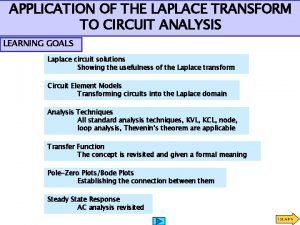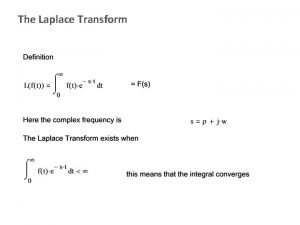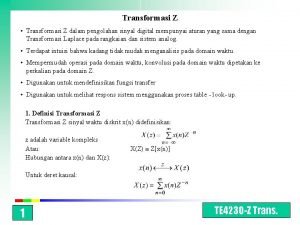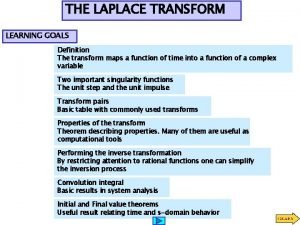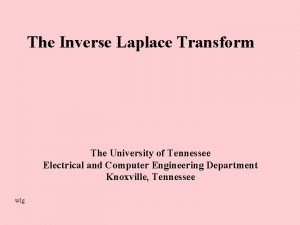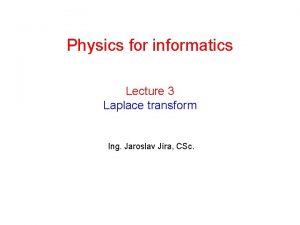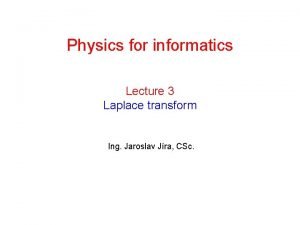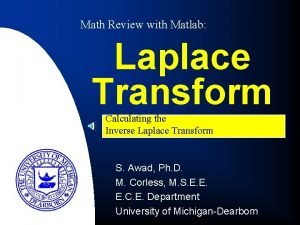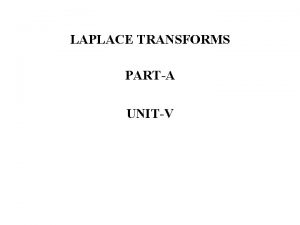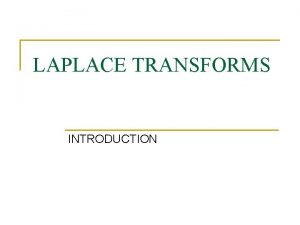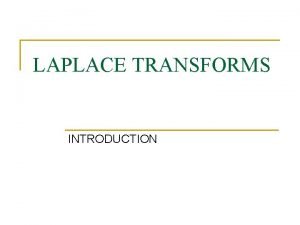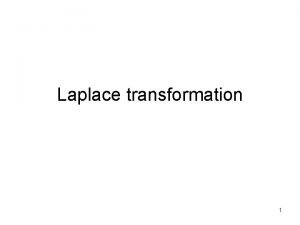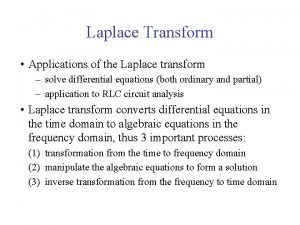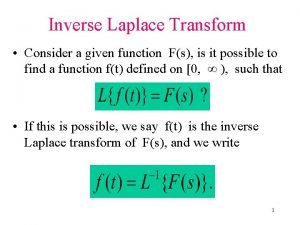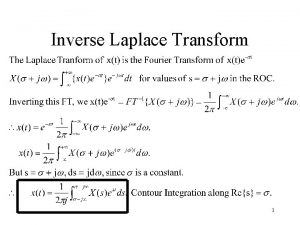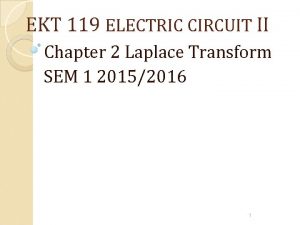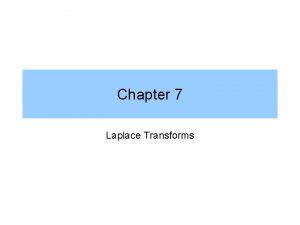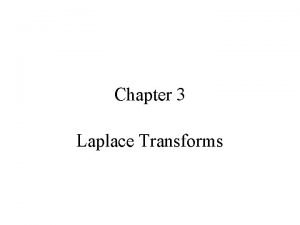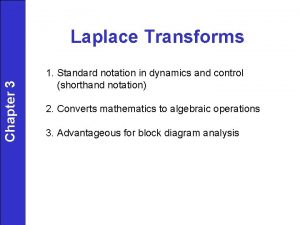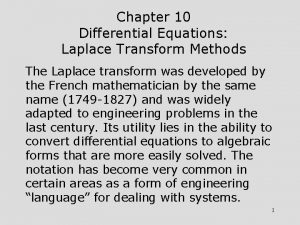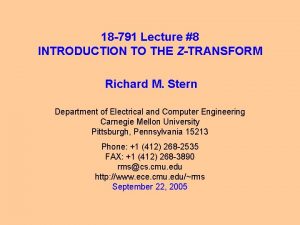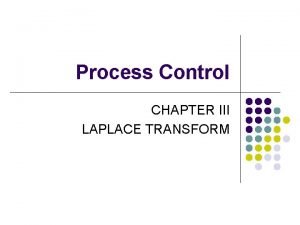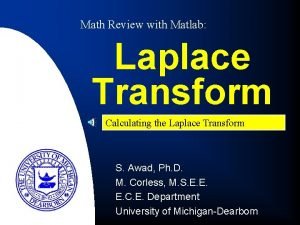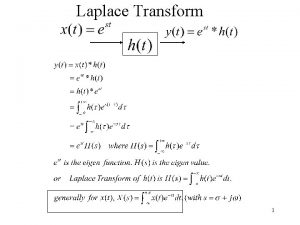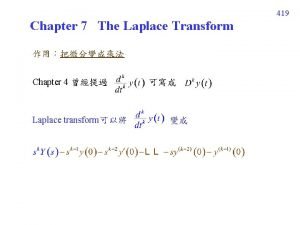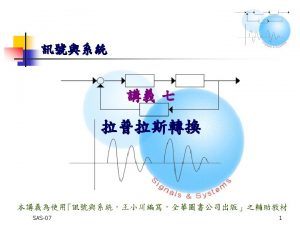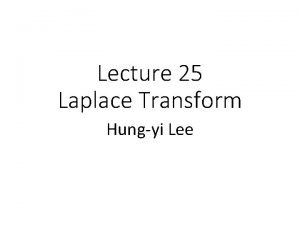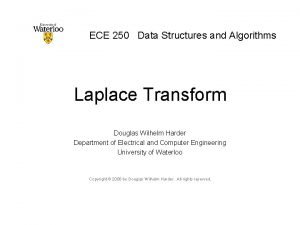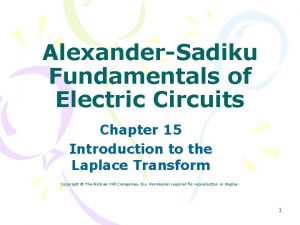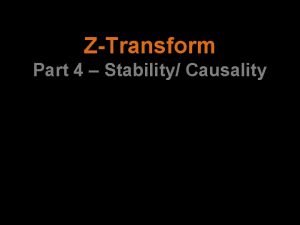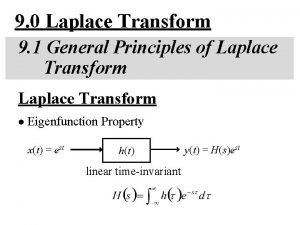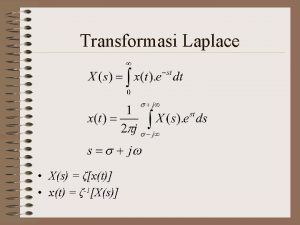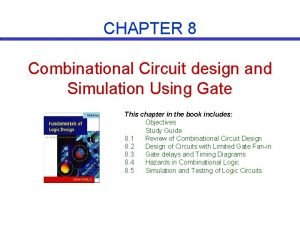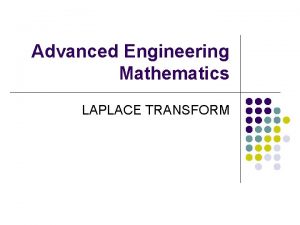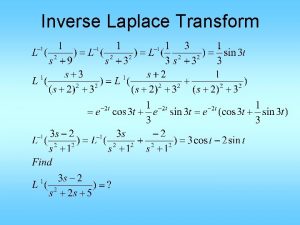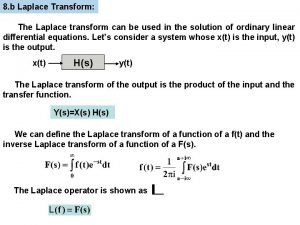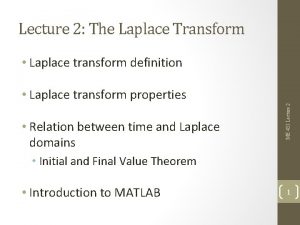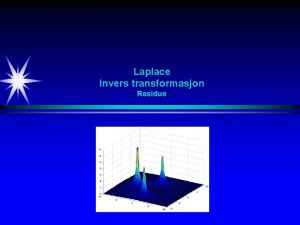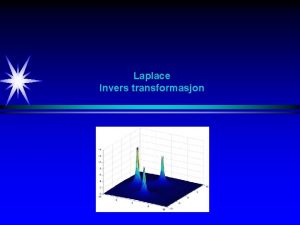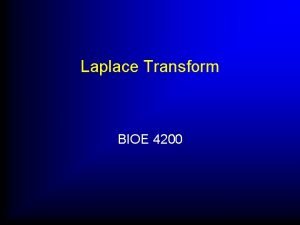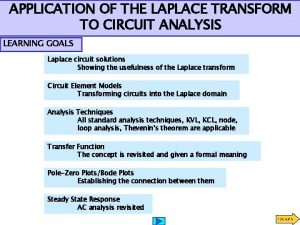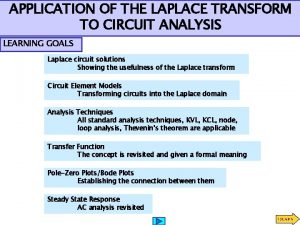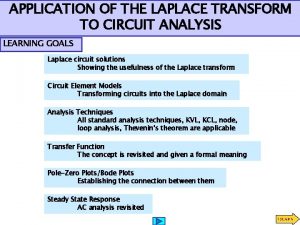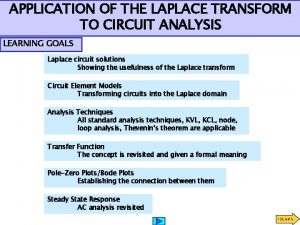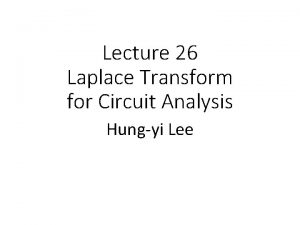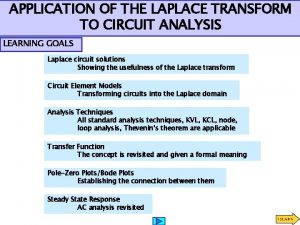CIRCUIT ANALYSIS USING LAPLACE TRANSFORM METHODOLOGY If the
























































- Slides: 56

CIRCUIT ANALYSIS USING LAPLACE TRANSFORM

METHODOLOGY If the circuit is a linear circuit YES Laplace transform of the sources of excitation: s(t) S(s) Laplace transform of the all the elements in the circuit Find the output O(s) in the Laplace freq. domain Obtain the time response O(t) by taking the inverse Laplace transform NO Stop or approximate the circuit into a linear circuit and continue Examples of nonlinear circuits: logic circuits, digital circuits, or any circuits where the output is not linearly proportional to the input. Examples of linear circuits: amplifiers, lots of OPM circuits, circuits made of passive components

THE s-DOMAIN CIRCUITS ± Equation of circuit analysis: integrodifferential equations. ± Convert to phasor circuits for AC steady state. ± Convert to s-domain using Laplace transform. ± KVL, KCL, Thevenin, etc.

KIRCHHOFF’S VOLTAGE LAW ± Consider the KVL in time domain: ± Apply the Laplace transform:

KIRCHHOFF’S CURRENT LAW ± Consider the KCL in time domain: ± Apply the Laplace transform:

OHM’S LAW ± Consider the Ohm’s Law in time domain ± Apply the Laplace transform

INDUCTOR ± Inductor’s voltage – In the time domain: – In the s-domain:

INDUCTOR ± Inductor’s current – Rearrange VL(s) equation:

CAPACITOR ± Capacitor’s current – In the time domain: – In the s-domain:

CAPACITOR ± Capacitor’s voltage – Rearranged IC(s) equation:

RLC VOLTAGE ± The voltage across the RLC elements in the s-domain is the sum of a term proportional to its current I(s) and a term that depends on its initial condition.

CIRCUIT ANALYSIS FOR ZERO INITIAL CONDITIONS (ICs = 0)

IMPEDANCE ± If we set all initial conditions to zero, the impedance is defined as: [all initial conditions=0]

IMPEDANCE & ADMITANCE ± The impedances in the s-domain are ± The admittance is defined as:

Ex. ± Find vc(t), t>0

Obtain s-Domain Circuit ± All ICs are zero since there is no source for t<0

Convert to voltage sourced s -Domain Circuit

Find I(s)

Find Capacitor’s Voltage ± The capacitor’s voltage: ± Rewritten:

Using PFE ± Expanding Vc(s) using PFE: ± Solved for K 1, K 2, and K 3:

Find v(t) ± Using look up table:

Ex. ± Find the Thevenin and Norton equivalent circuit at the terminal of the inductor.

Obtain s-domain circuit

Find ZTH

Find VTH or Voc

Draw Thevenin Circuit ± Using ZTH and VTH:

Obtain The Norton Circuit ± The norton current is:

Ex. ± Find v 0(t) for t>0.

s-Domain Circuit Elements Laplace transform all circuit’s elements

s-Domain Circuit

Apply Mesh-Current Analysis Loop 1 Loop 2

Substitute I 1 into eqn loop 1

Find V 0(s)

Obtain v 0(t)

CIRCUIT ANALYSIS FOR NON ZERO INITIAL CONDITION (ICs ≠ 0)

TIME DOMAIN TO s-DOMAIN CIRCUITS ± s replaced t in the unknown currents and voltages. ± Independent source functions are replaced by their s-domain transform pair. ± The initial condition serves as a second element, the initial condition generator.

THE ELEMENTS LAW OF s. DOMAIN

THE ELEMENTS LAW OF s. DOMAIN

TRANSFORM OF CIRCUITSRESISTOR ± In the time domain: ± In the s-domain:

TRANSFORM OF CIRCUITSINDUCTOR ± In the time domain:

TRANSFORM OF CIRCUITSINDUCTOR ± Inductor’s voltage: ± Inductor’s current:

TRANSFORM OF CIRCUITSCAPACITOR ± In the time domain:

TRANSFORM OF CIRCUITSINDUCTOR ± Capacitor’s voltage: ± Capacitor’s current:

Ex. ± Find v 0(t) if the initial voltage is given as v 0(0 -)=5 V

s-Domain Circuit

Apply nodal analysis method

Cont’d

Using PFE ± Rewrite V 0(s) using PFE: ± Solved for K 1 and K 2:

Obtain V 0(s) and v 0(t) ± Calculate V 0(s): ± Obtain V 0(t) using look up table:

Ex. ± The input, is(t) for the circuit below is shown as in Fig. (b). Find i 0(t) is(t) 1 (a) 2 0 (b) t(s)

s-Domain Circuit

± Using current divider:

Derive Input signal, Is is 1(t) is(t) t 1 0 is 2(t) 0 2 t(sec) 0 2 t

Obtain Is(t) and Is(s) ± Expression for is(t): ± Laplace transform of is(t):

± Substitute eqn. (2) into (1):

Inverse Laplace transform
 Laplace transform of inductance
Laplace transform of inductance Capacitor laplace
Capacitor laplace Laplace transform.table
Laplace transform.table Tranformasi z
Tranformasi z Laplace transform
Laplace transform Laplace transform of 1
Laplace transform of 1 Laplace transform complex roots
Laplace transform complex roots Mat 275
Mat 275 Laplace transform differential equation
Laplace transform differential equation Laplace transform differential equation
Laplace transform differential equation Inverse laplace transform in matlab
Inverse laplace transform in matlab Laplace transform of impulse
Laplace transform of impulse Final value theorem
Final value theorem Laplace transform
Laplace transform Laplace transform of a constant
Laplace transform of a constant State a laplace transform function and explain the meaning
State a laplace transform function and explain the meaning Laplace inverse of 1
Laplace inverse of 1 Inverse laplace formula
Inverse laplace formula Laplace transform symbol
Laplace transform symbol Bilateral laplace transform table
Bilateral laplace transform table Heaviside method
Heaviside method Laplace transform table
Laplace transform table Differential laplace transform
Differential laplace transform Z transform vs laplace
Z transform vs laplace Formula of inverse laplace transform
Formula of inverse laplace transform Laplace transformation matlab
Laplace transformation matlab Relation between fourier and laplace transform
Relation between fourier and laplace transform T^1/2 laplace
T^1/2 laplace S shifting theorem
S shifting theorem Laplace transform formula
Laplace transform formula Laplace derivative
Laplace derivative Unilateral laplace transform
Unilateral laplace transform Find the laplace transform of 15/2
Find the laplace transform of 15/2 Stability and causality of z transform
Stability and causality of z transform Unit impulse function laplace
Unit impulse function laplace Transformasi laplace
Transformasi laplace Laplace transform piecewise
Laplace transform piecewise Laplace inductor
Laplace inductor Find vo using mesh analysis
Find vo using mesh analysis Voltage in parallel circuit
Voltage in parallel circuit Parallel circuit vs series circuit
Parallel circuit vs series circuit Parallel circuit circuit construction kit
Parallel circuit circuit construction kit Capacitor series parallel
Capacitor series parallel Complete and incomplete circuit
Complete and incomplete circuit Short circuit schematic
Short circuit schematic Klews chart
Klews chart Blood circulation system diagram
Blood circulation system diagram Advantages of parallel circuits over series circuit
Advantages of parallel circuits over series circuit Method
Method Business process analysis methodology
Business process analysis methodology Structured system analysis and design
Structured system analysis and design Ssadm model
Ssadm model Methodology of econometric analysis
Methodology of econometric analysis Combinational circuit design and simulation using gates
Combinational circuit design and simulation using gates Simulation and testing of logic circuits
Simulation and testing of logic circuits Design a combinational circuit using rom
Design a combinational circuit using rom Fourier transform complex analysis
Fourier transform complex analysis
